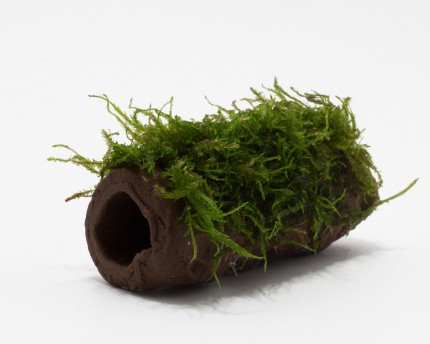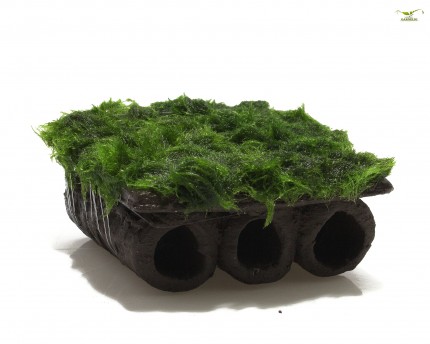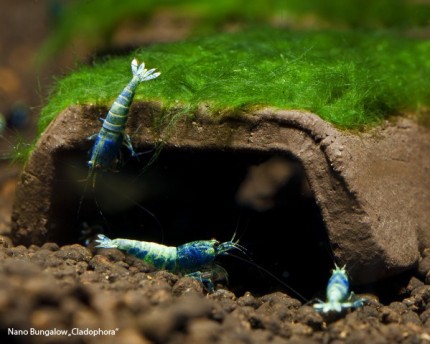Macrobrachium large arm shrimp - keeping in the aquarium
Many of the beautifully patterned and often with long claw arms quite bizarre looking large arm shrimp / long arm shrimp of the genus Macrobrachium are very well kept in the aquarium, and they are also becoming increasingly popular outside their loyal fan community. Since they differ not only in behavior, but also in the demands on the aquarium but sometimes very clearly from the better known dwarf shrimp, we would like to dedicate today's blog to these fascinating invertebrates.
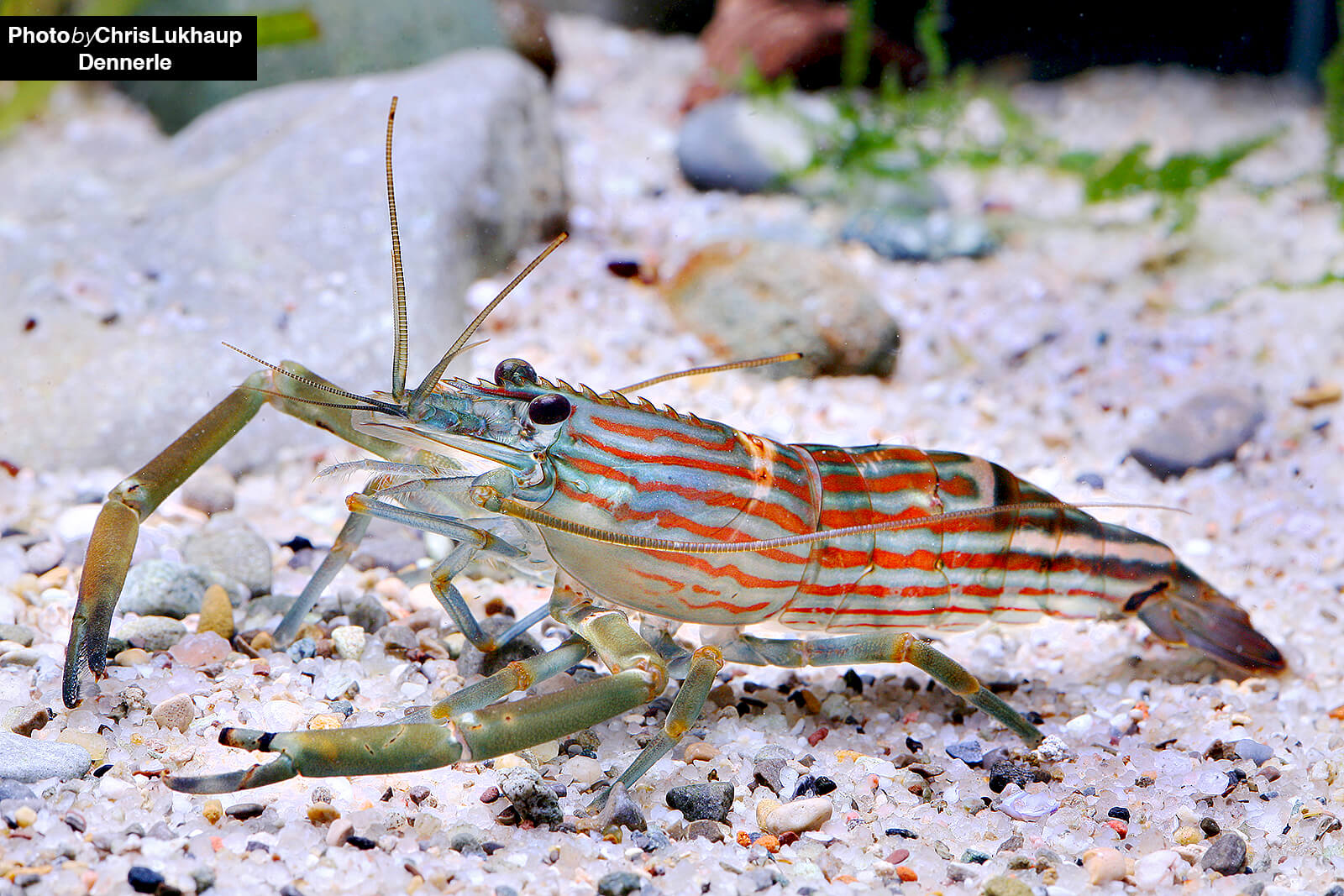
What is the difference between crayfish and macrobrachia?
Especially the males of the larger representatives look, depending on the species, with their large claw arms at first glance quite similar to crayfish and are also often confused with them. However, a sure distinguishing feature is which of the pairs of claw bones is strongly enlarged - in crayfish the large claws are always located on the first pair of claw bones, while in large-armed shrimp the first pair of claw bones is rather small, and in them the second pair of claw bones is enlarged.
Unlike dwarf shrimp, which are social group animals and should not be kept alone, many large-armed shrimp species, especially the larger representatives, are often strongly territorial. Especially with the males, territorial disputes and rivalries for females can lead to fights, which can even end fatally from time to time. In the descriptions of the individual species is listed in each case whether the animals can be kept in groups or not. Normally the males tolerate female large arm shrimp in their proximity, depending on the species the females are even protected very carefully and persistently.
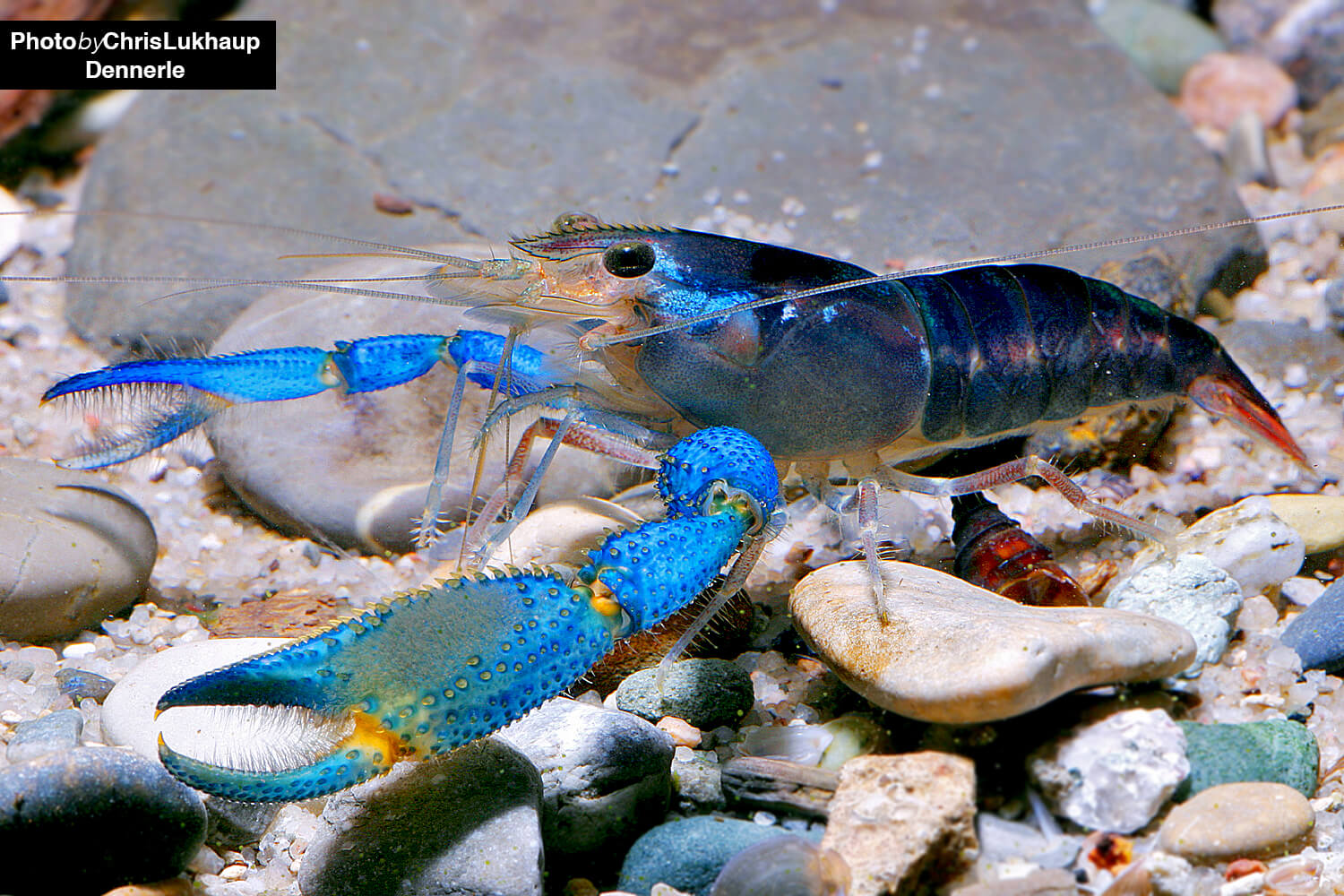
Sex differences in Macrobrachium shrimp
Males and females can be distinguished relatively well in the larger large-armed shrimp species. The males have significantly longer and much more pronounced claw arms, while the females not only have smaller claw arms, but also do not come close to the males in overall body length. Instead, they are much chubbier, especially on the abdomen
Group keeping of large arm shrimp
If you want to keep one or even more pairs of large-armed shrimp in your aquarium, you have to pay attention to a sufficiently large base area and should equip the aquarium extremely well with Stone structuresopen on two sides Caves and Root wood structure. This way the animals can avoid each other visually in case of quarrels or in the critical phase during and shortly after molting. Macrobrachia do not dig and therefore do not dig up the substrate in the aquarium, unlike many crayfish. Large-armed shrimps also do not like plants as much as some crayfish, so the aquarium can be planted for Macrobrachia - but you should still leave plenty of space for the sometimes quite large animals to crawl. Swimming space on the other hand large arm shrimp do not need much, because they hardly swim actively.
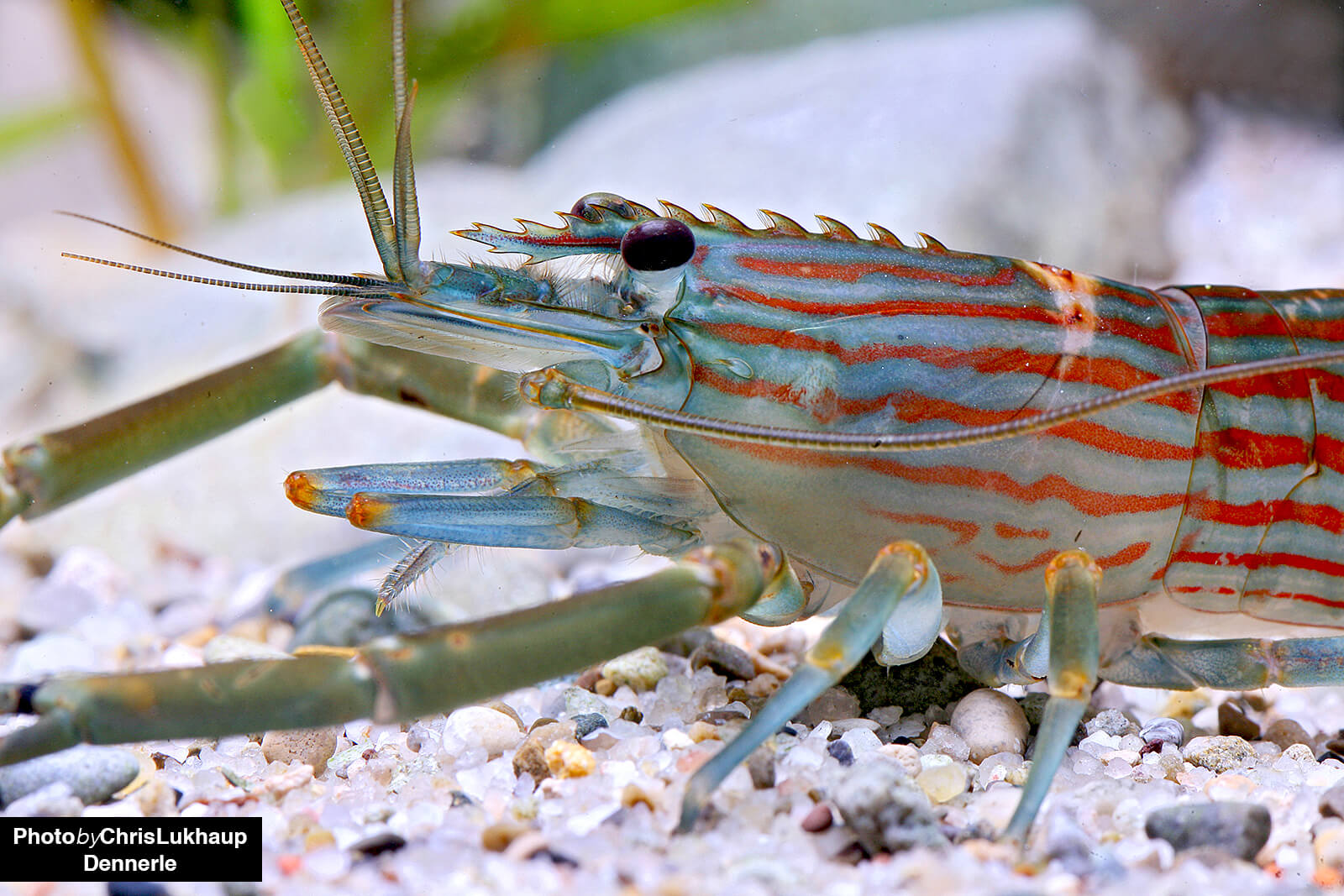
Socialization of Macrobrachium species
A socialization with dwarf shrimps can - depending on the species of Macrobrachium - go well or not. There are representatives like the Burma shrimp, also called Inlesee shrimp (Macrobrachium peguense), which are very compatible and can be kept together not only with dwarf shrimp, but also with medium-sized, not too curious fish, which do not sleep on the bottom. Other Macrobrachia on the other hand are skillful and nimble predators, where fish and also dwarf shrimp have no chance and become food, for example the Rose Mountain Shrimp (Macrobrachium rosenbergi). Snails eat all large arm shrimps gladly, they definitely belong to their favorite food. Depending on the species, even mussels are cracked and eaten. Macrobrachia should never be socialized with crabs and shrimps, these invertebrates are not compatible and fights to the death will occur.
Diet
Although there are Macrobrachium species that will eat more or less anything, most large-armed shrimp do place a definite emphasis on carnivorous foods. They not only eat carrion and freshly dead animals, but also actively hunt. A good protein food given several times a week is definitely appropriate, but freeze-dried food animals (FD food), frozen food and live food such as water fleas, snails or grindalworms are also very popular. Some brown autumn leaves in the aquarium is never wrong with invertebrates, it acts as a permanent food source and also influences the water values positively.
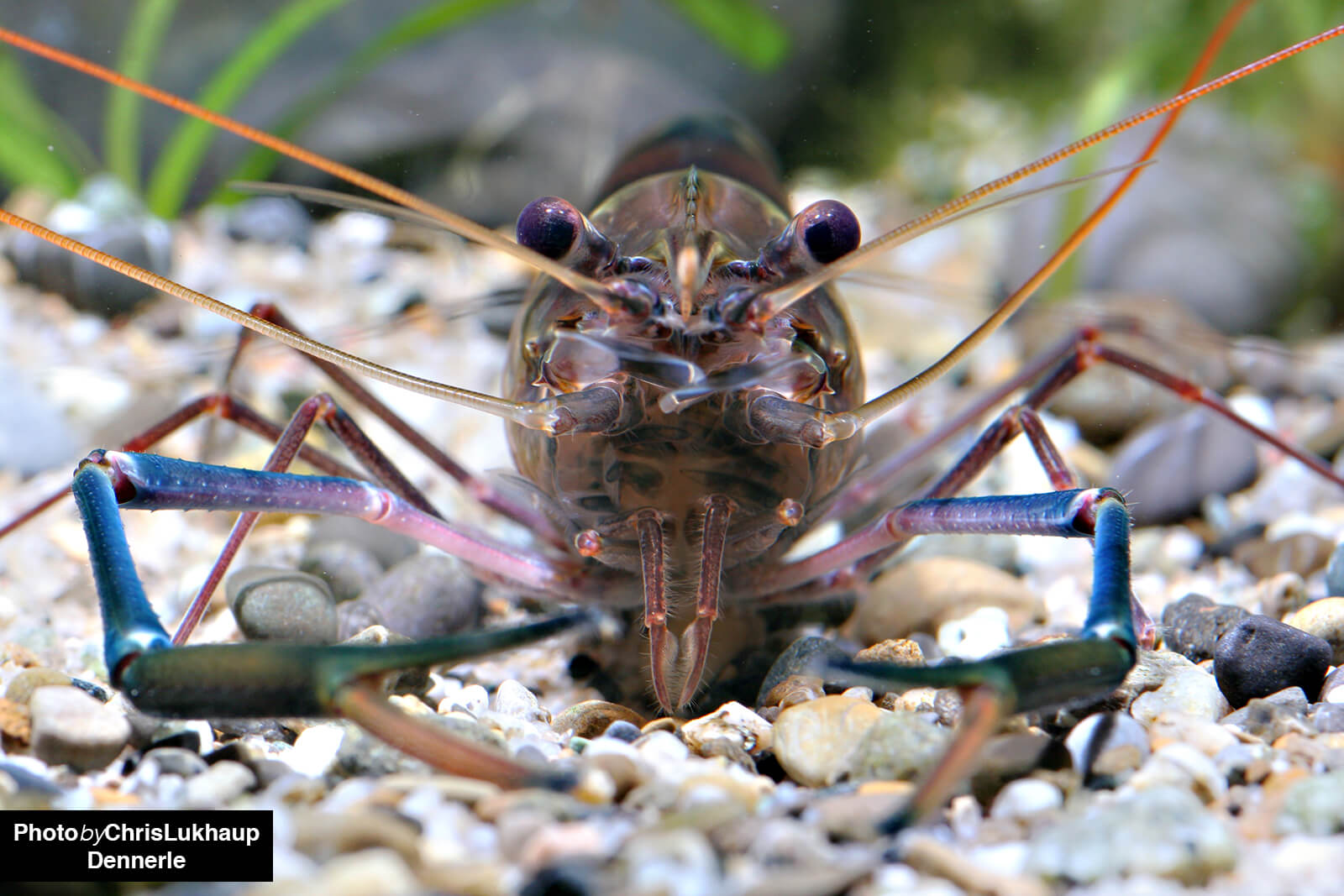
Suitable water values!
When it comes to water values, Macrobrachium large arm shrimp are not as sensitive as dwarf shrimp. They are often found in larger flowing waters and are therefore more adapted to fluctuating water values, for example after heavy rainfall. With rather soft to medium hard water and a pH-value between 7 and 7,5 you do everything right in most cases. Temperatures of 22 to 26 °C are correct for animals originating from temperate to subtropical climate zones - in most cases large-armed shrimp can be kept at room temperature. If individual species require different values, you will find this information in our descriptions of the individual species.
Reproduction of the large arm shrimp!
The reproductive strategies of large-armed shrimp are different. As with dwarf shrimp, crabs and shrimp, eggs are carried under the abdomen and nursed until the young hatch. There are Macrobrachium species that rely on few offspring, but they develop a great deal while still in the egg and are born as a finished small large-armed shrimp. They grow up in fresh water without any problems and can be raised in the aquarium of their parents. Then there are those species that release myriads of offspring that must first pass through various larval stages before metamorphosing into the finished small juvenile shrimp. These benthic larvae live free-floating in the water and feed primarily on plant and animal plankton. They require brackish or seawater and therefore cannot develop in freshwater aquariums.
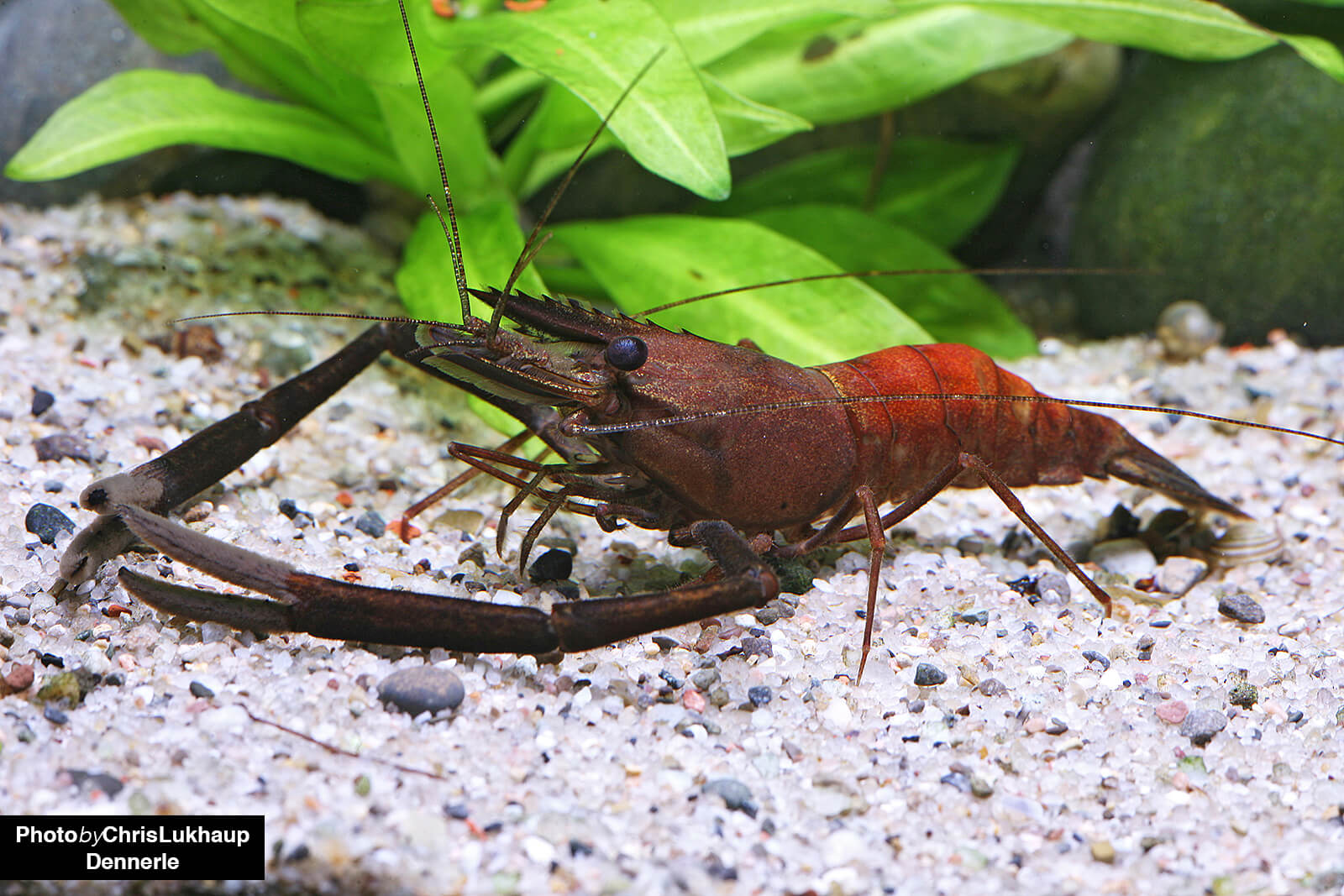
Roland Emmenlauer: "Macrobrachium peguense have fascinated me for years!"

Roland Emmenlauer, author of the e-book"Crayfish Aquarium for Beginners," has been involved with with invertebrates since his early childhood. Roland is also the founder of the successful Nanoaquarium for Beginners groups and the Cambarellus, Cherax, Procambarus group on Facebook
Macrobrachium peguense (also called "red scissors shrimp" or "Inlesee Burma" as a reference to their origin) have fascinated me for years, which is why I have specialized in the care of this interesting species. They are always busy and offer the observer an exciting entertainment program. Once you learn to appreciate them, you don't need any other company in the species tank. My macro tank is my favorite television program. When the little musketeers are not foraging, they practice fencing. Fearlessly they face their opponent and excitedly wave their scissors to impress him or to get an advantage
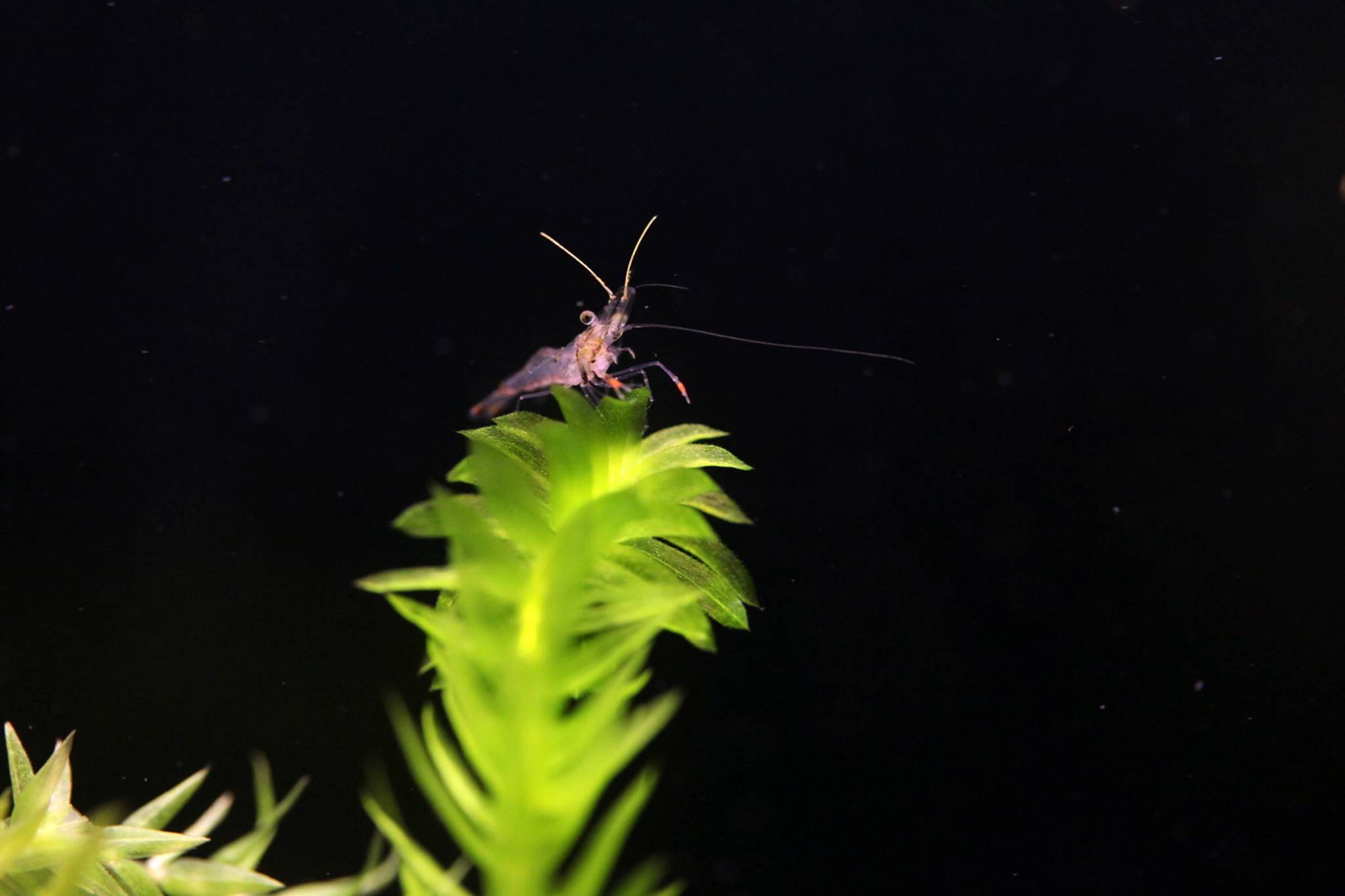
Occasionally a pair of scissors is lost, but otherwise it never leads to serious injury, so the performance is quite child-friendly. If one wants to socialize them with other invertebrates, abundant protein feeding is obligatory, because otherwise losses of offspring are to be expected. However, they prefer small accompanying fauna if not overfed, which is why nothing crawls or twitches in my macro tank that might otherwise reassure invertebrate keepers. Not a worm, not a ostracod, not a hopper crab - everything becomes macro food if it dares to come out of the substrate. Therefore their call "planarian eaters" seems understandable to me. Besides this self-sufficiency, they are happy to eat a wide range of food. Mine like to eat fish food, granules and flake food as well as spirulina tabs
You will experience joyful enthusiasm if you offer them mosquito larvae and artemia, preferably live food, but frozen food is also gladly accepted. If you have thread algae infestation on inventory and plants, then this is also a treat for the frugal troop. They are regularly served moss balls into the tank, which they gnaw off spotless, so that they can return to the scaping tank proverbially retreaded. They take care of filamentous algae destruction so successfully that I was surprised that this is not commonly known, like with the Amano shrimp. If one wishes to successfully propagate the Musketeers, there are a few things to consider. In addition to adequate feeding, there needs to be a nursery for the offspring so they can grow up undisturbed. I recommend to provide a corner with a ground cover like Lomariopsis lineata "freshwater kelp" or Fissidens fontanus. Visually very beautiful and very easy to maintain is a grass like Lilaeopsis brasiliensis, as offered by the company Dennerle as pads. If you want to make it easy, you can add Najas goudalupensis "Nixkraut" to the tank. It is only important that the plants tolerate it a little warmer. Besides such planting, the animals also need swimming space, which is why I keep them in a meter tank.
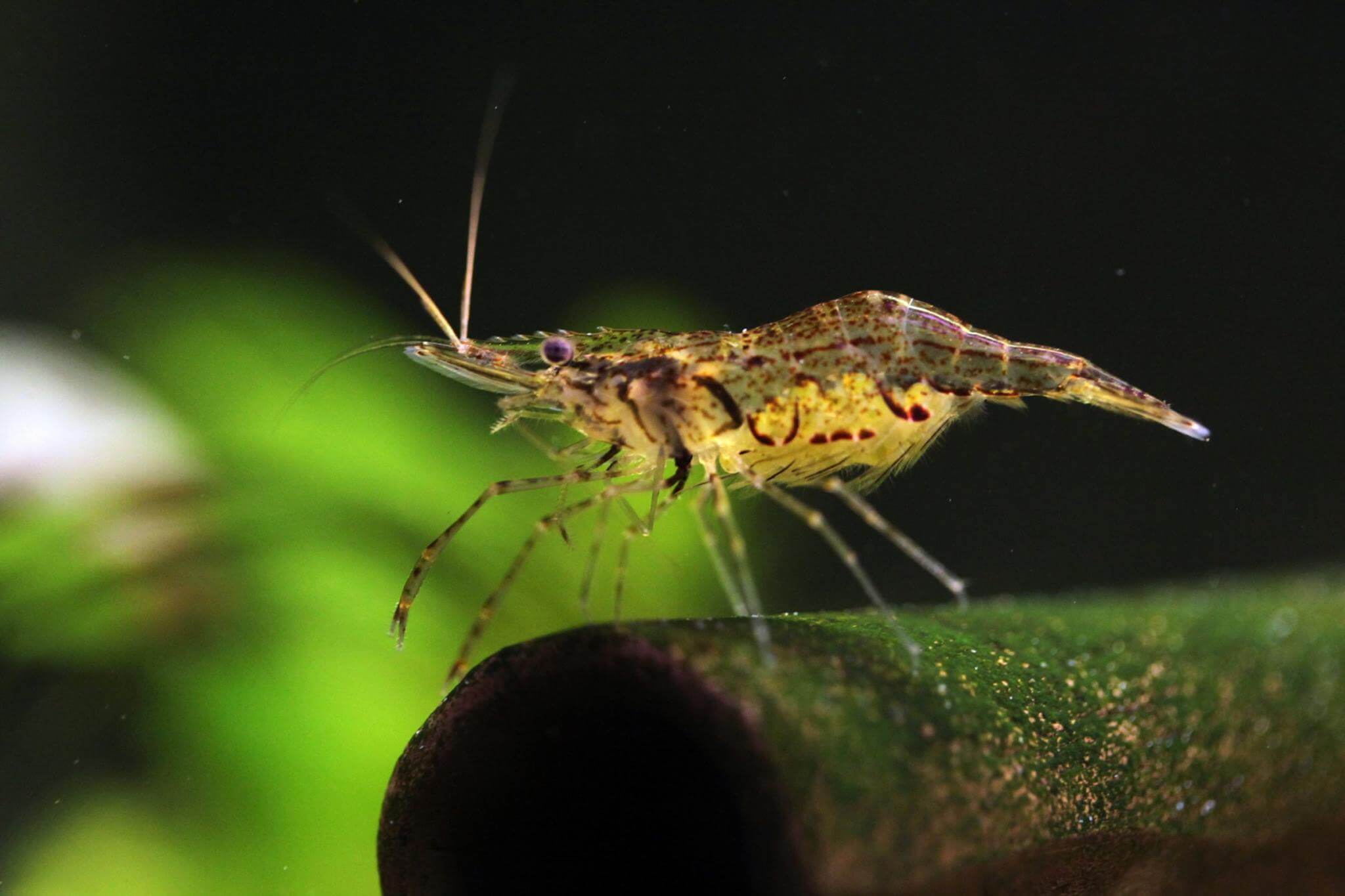
To enjoy these animals properly, I would not put them under 80 cm edge length and rather use a large troop. The larger the group, the greater the food envy and the faster they reproduce, which guarantees a lot of fun observing them. In the water chemistry the macros are undemanding, mine live at 400 µS, a KH of 8 and a pH of 7.6 and reproduce like rabbits. I know from acquaintances that they tolerate a whole range, even much softer water. However, the water temperature must be increased to about 26°C, only then the macros get into mating mood. If the conditions are good, the males lay sperm packets on the legs of the somewhat larger females. This way the eggs are fertilized as soon as the female pushes them out. The eggs are small, but in greater numbers. Soon you can observe little hooked fish in the tank, exploring the underwater world with big eyes.
Macrobrachium species at a glance:
Snowflake shrimp, Arachnochium kulsiense
Introducing the most popular species, we start with a large-armed shrimp, which is not (anymore) considered to be a member of the genus Macrobrachium: The snowflake shrimp Arachnochium kulsiense from India is a very compatible with up to 5 cm body length rather small remaining longarm shrimp with relatively thin, weak arms, which is neither fish nor dwarf shrimp dangerous. This rather shy and reserved large-armed shrimp should be kept in a group, the housemates must not be too pushy and curious. Hiding places are very important for this shrimp. It eats mainly vegetable food, but also likes protein containing food of animal origin. Arachnochium kulsiense reproduces in freshwater.
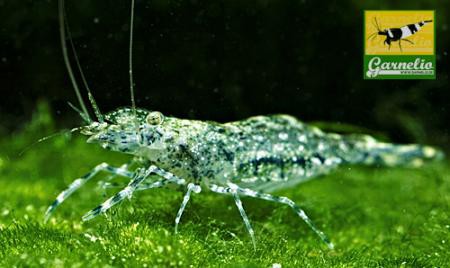
Burmese shrimp, Macrobrachium peguense
Also good to keep in a group is the Burmese shrimp Macrobrachium peguense, also known as Macrobrachium sp. Inlesee. It is not only compatible with conspecifics, but also with dwarf shrimp and small to medium sized fish, and it is highly valued for its food selection: the
Shrimp eats planarians, which are very undesirable in the invertebrate aquarium. With a body length of up to 5 cm, it also belongs to the rather small large-armed shrimp. It reproduces in fresh water and is very easy to breed. The juveniles can stay with the parents in the aquarium without problems and are not strongly cannibalistic among themselves. Besides planarians, the Burmese shrimp also likes to eat protein food, frozen food and so on, but does not say no to plant-based food from time to time.
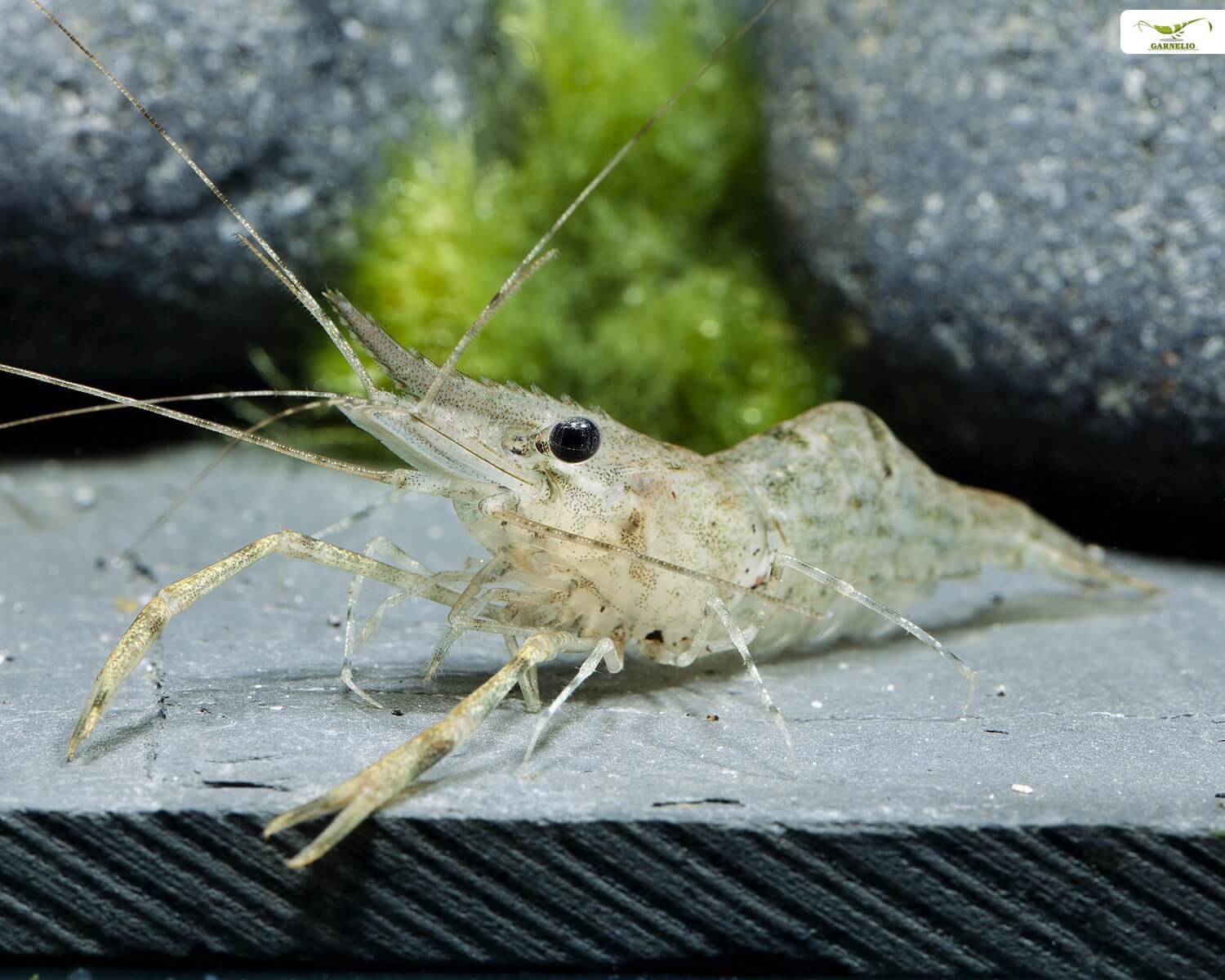
Glass shrimp, Macrobrachium lanchesteri
With a body length of up to 10 cm the glass shrimp, Macrobrachium lanchesteri, is somewhat larger than the two species mentioned above. But it is also quite compatible with conspecifics and can be kept in a group. For fishes their relatively small claws are not dangerous, but on dwarf shrimps the glass shrimp goes from time to time. The pretty transparent animals with the black stripe pattern are a nice addition to the community aquarium, but also make a good figure in the species tank. As an omnivore, it also likes vegetable food in addition to animal food. It can reproduce in freshwater, but belongs to the partially abbreviated reproduction type and releases highly developed larvae, which fully transform into the finished shrimp in freshwater. In a community aquarium with fish breeding is therefore rather unlikely.
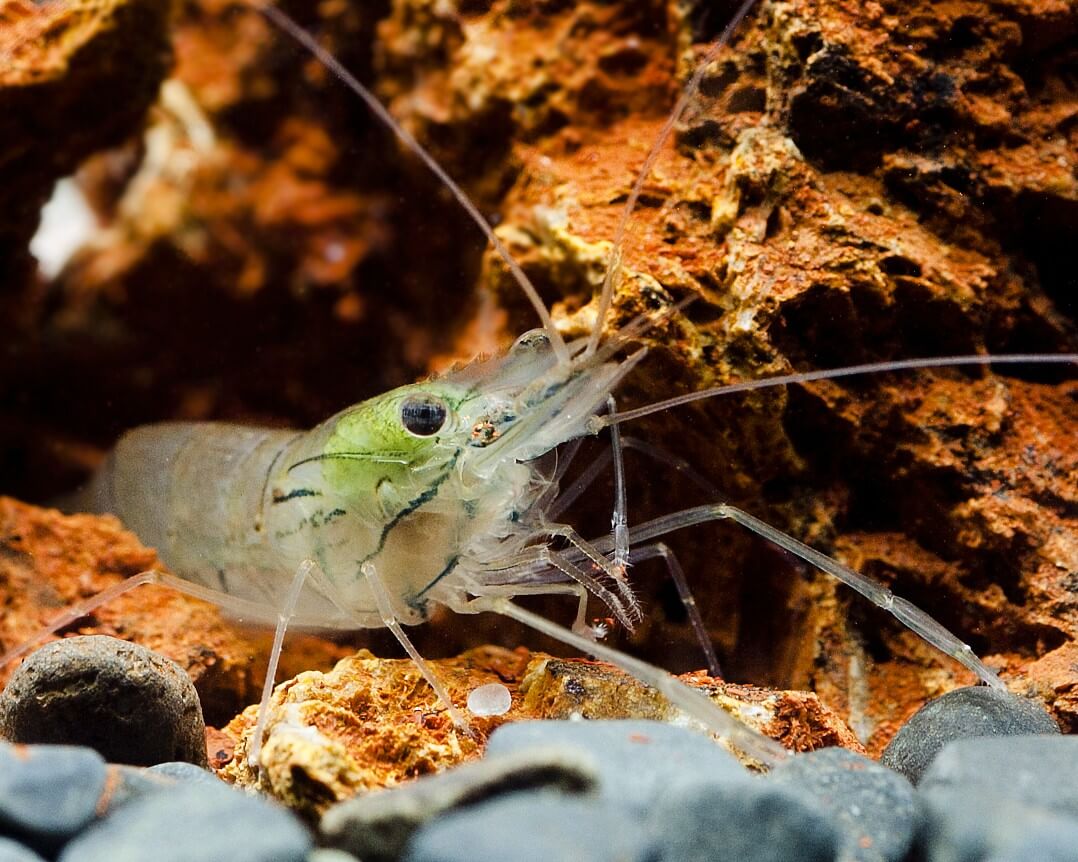
Ringed shrimp, Macrobrachium assamense
A little bit smaller, but also a little bit less compatible with conspecifics is the ringed shrimp Macrobrachium assamense, which has young animals with strikingly ringed claw legs, just like the species Macrobrachium dayanum, which is very similar in behavior and appearance. The ringing is absent from the age form. Adults are reddish brown to chocolate brown, which has earned them the name Red Rusty shrimp. Keeping them in pairs is unproblematic in well structured aquariums. The ringed shrimp can be socialized with dwarf shrimp, which reproduce well. However, one or the other shrimp will certainly be preyed upon. Fish are also hunted and eaten depending on the character of the ringed shrimp. The diet should be clearly protein-heavy, ring-necked shrimp are carnivores, we do very well with Natureholic Proteinfeed! After the six to eight week gestation period, females release fully developed juveniles that can grow in freshwater, but they can already be quite cannibalistic and definitely need a lot of hiding places for successful rearing.
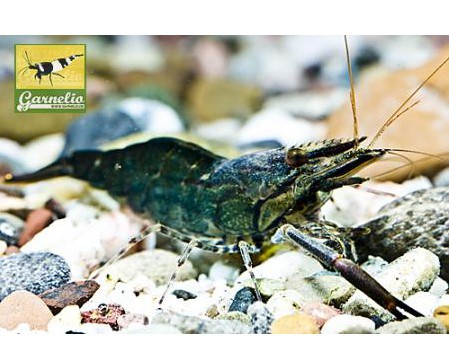
Tiramisu leaf shrimp, Macrobrachium pilimanus
Also the male Tiramisu Leaf Shrimp Macrobrachium pilimanus are a bizarre sight in the aquarium with their different sized and strongly hairy claws. These large-armed shrimp, which are quite small at up to 6 cm, are also quite territorial, but the males tolerate females in their territories. They can reproduce in freshwater, although the females release larvae. These larvae survive in the aquarium and soon become small deciduous shrimp, provided there are no fish in the aquarium to eat them. Leaf shrimp also eat mostly food of animal origin.
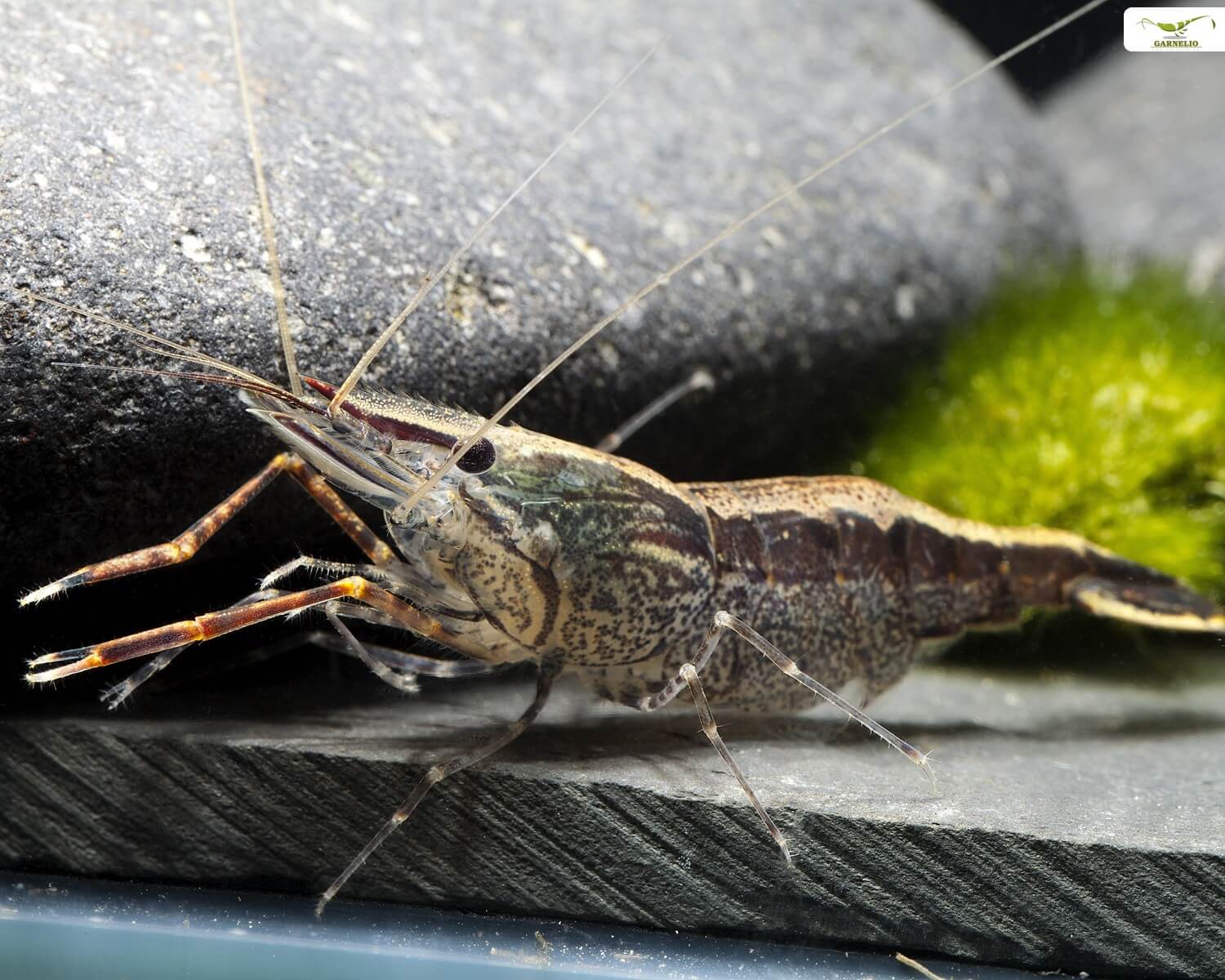
Blue giant hand shrimp, Macrobrachium rosenbergi
For fans of the very large Macrobrachia, the decidedly aggressive and very territorial Macrobrachium rosenbergi is an attractive option. At well over 20 cm in body length, this beautiful bluish large-armed shrimp is an impressive aquarium resident, but must be kept alone. Even with the opposite sex Macrobrachium rosenbergi are not compatible. In its native Southeast Asia it plays an extremely important role as an edible shrimp. The larvae need salt water for breeding, so in a freshwater aquarium reproduction would not be possible anyway. Macrobrachium rosenbergi prefers a high protein diet, invertebrates of all kinds are excellent sources of protein. Fish are also caught and eaten with enthusiasm, and snails are among their absolute favorite foods.
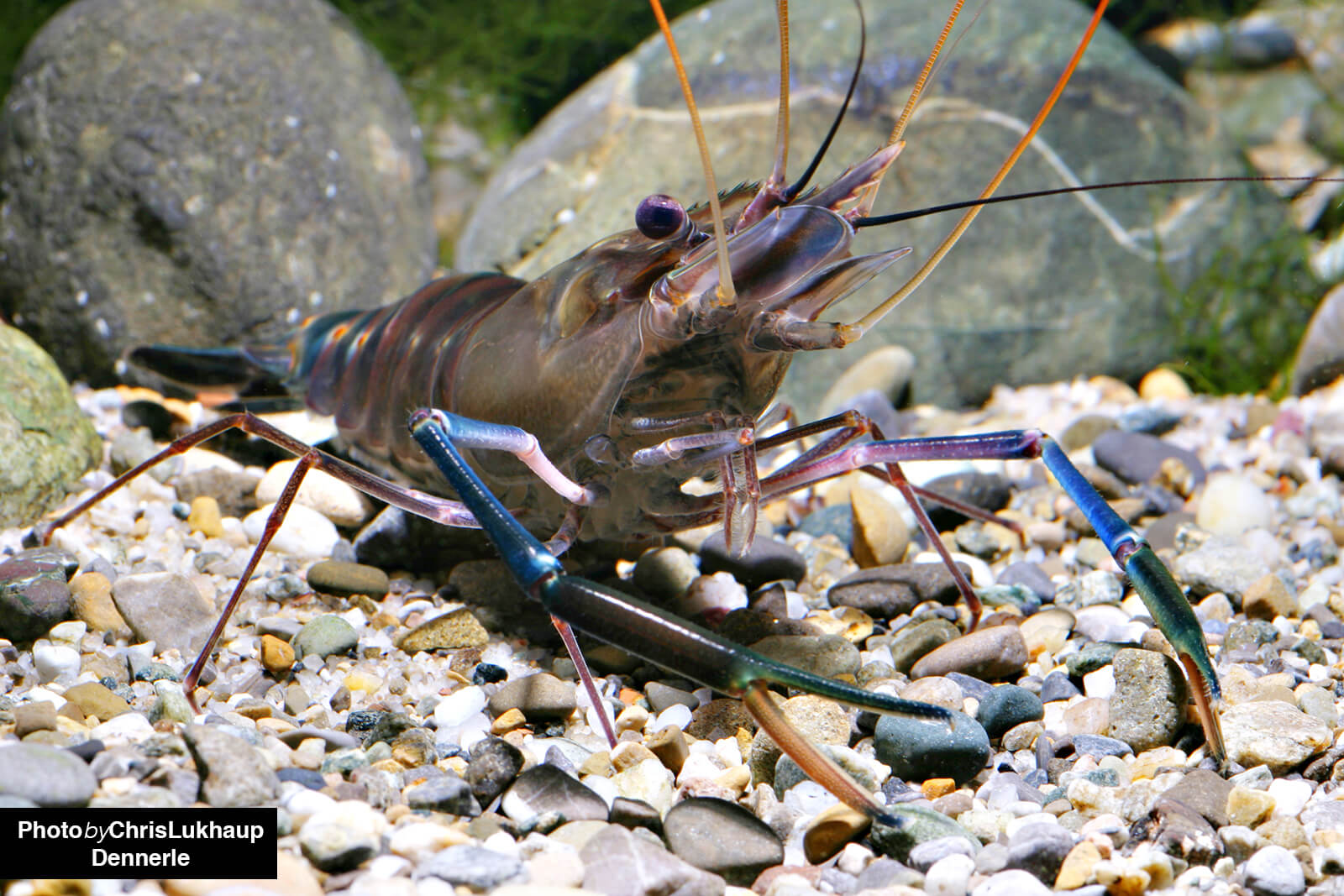
Colourpoint large arm shrimp, Macrobrachium horstii
Also a rather rare guest in local aquariums is the colorpoint large arm shrimp Macrobrachium horstii. With a body length of only 7 cm it is not as big as the Rosenberg shrimp, and it is much better tolerated, but it is not often imported and is considered a rarity in this country. The males tolerate one or more females in their proximity. The larvae require salt water for development. The colorpoint large arm shrimp is an omnivore with a distinct emphasis on animal foods.
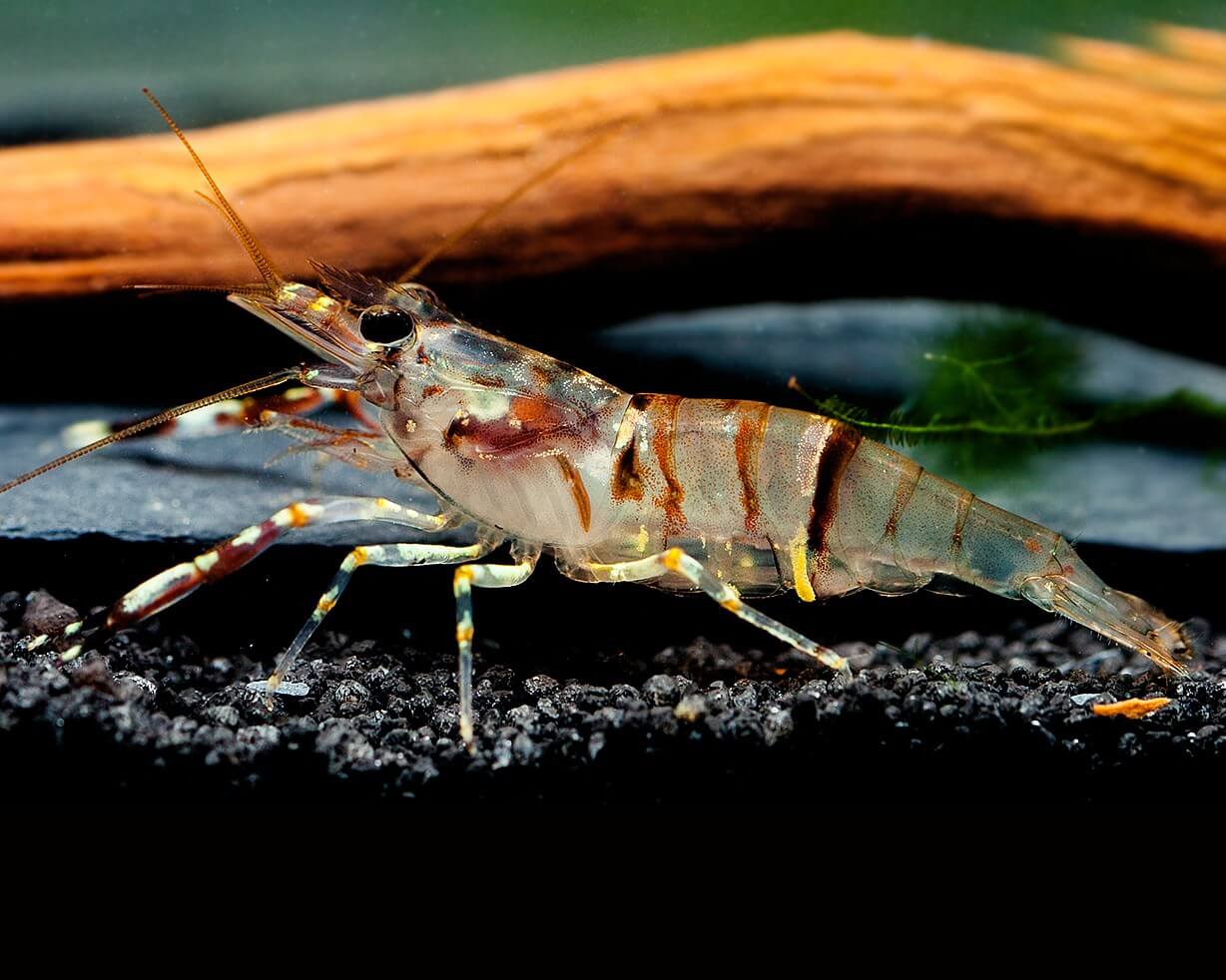
Lemon large arm shrimp, Macrobrachium gracilirostre
Very attractive colors and pattern and therefore in great demand - the Lemon Large-Arm Shrimp Macrobrachium gracilirostre, with its 8 cm body length and the blue-red-brown longitudinal stripes is a very pretty animal, which unfortunately cannot reproduce in freshwater. Its larvae need salt water for breeding. Males and females are quite compatible, you can even keep the Lemon large-armed shrimp in small groups if the aquarium is well structured. As an omnivore, it still needs protein-rich food, like all large-armed shrimp.
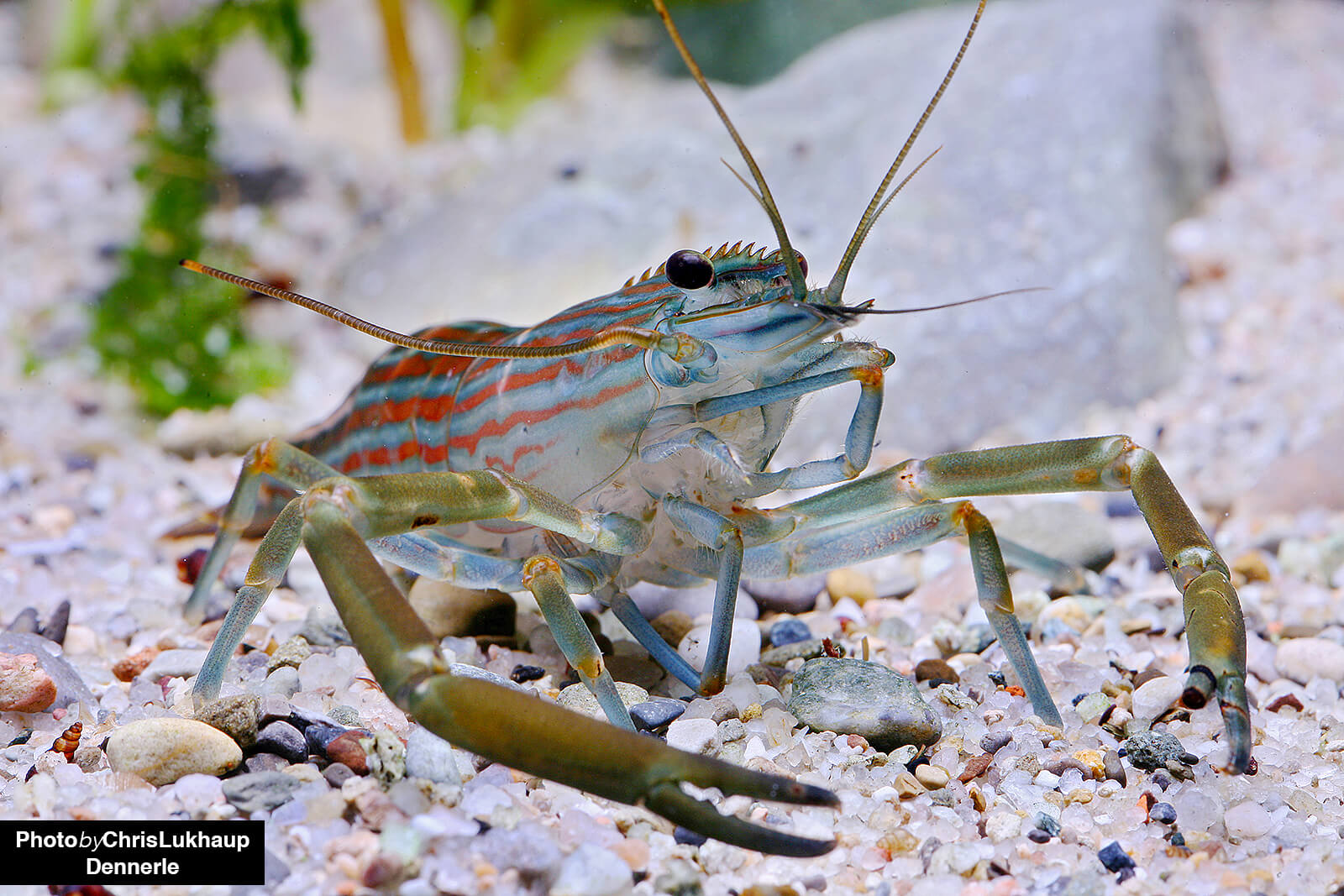
Dafa large arm shrimp, Macrobrachium jaroense
Quite similar is the with 6 cm rather small Dafa large arm shrimp Macrobrachium jaroense, also it is rather an omnivore and can be kept in varied aquariums, which offer much cover, also in the group. Their larvae also need salt water.
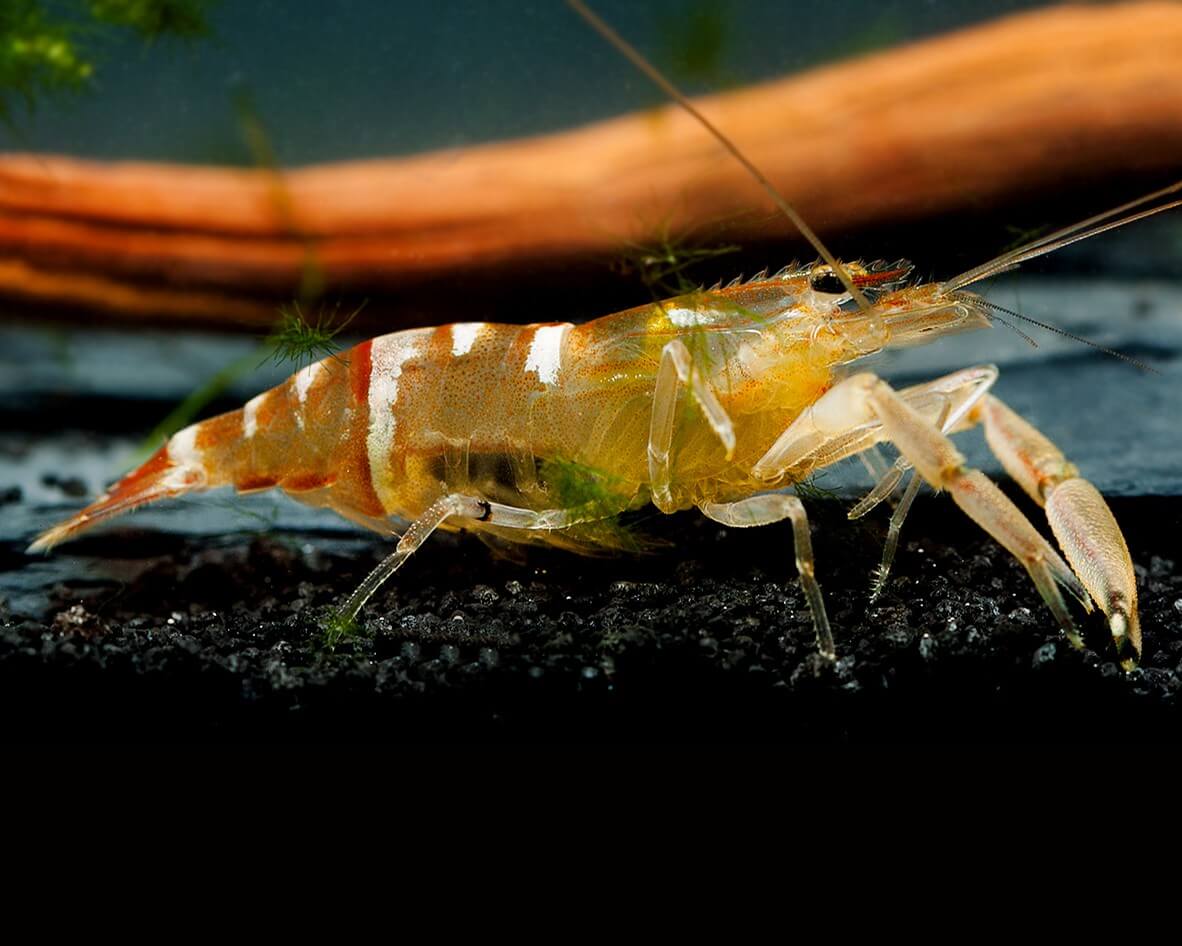
Bumblebee large-armed shrimp, Macrobrachium agwi
Different is the only 5 cm small Macrobrachium agwi - the dwarf large-armed shrimp, also called Bumblebee large-armed shrimp, can reproduce in freshwater and can be kept as a pair or as a small group. Animal components in its food are important to it, even though it is actually an omnivore.
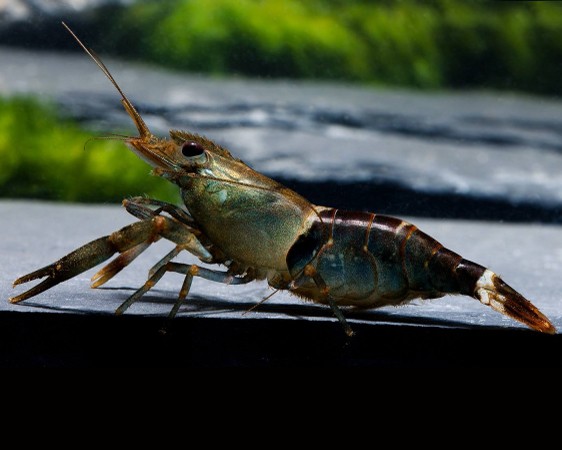
Red Stripes Large-Arm Shrimp, Macrobrachium esculentum
Another pretty large-armed shrimp is Macrobrachium esculentum, which looks almost like a Moluccan fan shrimp with its reddish-brown stripes. Unlike most other Macrobrachium species, it likes hard to very hard water and is even found in the brackish water areas of estuaries and mangrove swamps. It also does not reproduce in freshwater, but releases larvae that grow in brackish to seawater. In its countries of origin, it serves as an important edible shrimp.
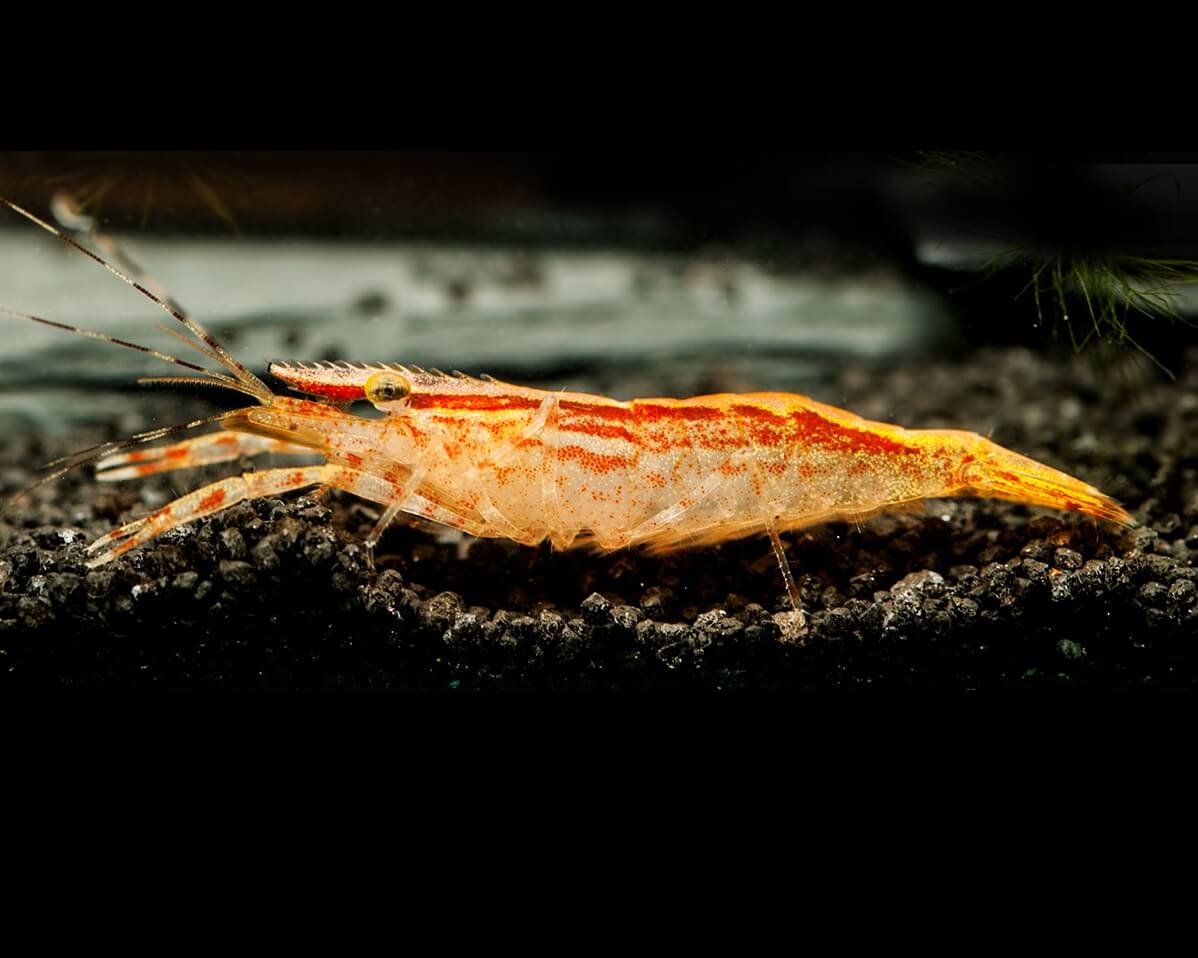
Blue & White large arm shrimp, Macrobrachium scabriculum
The Blue & White large arm shrimp Macrobrachium scabriculum stands out with its coloration and patterning. With its body length of up to 12 cm and the strong, in the males conspicuously hairy claws it is certainly a nice alternative to crayfish in the aquarium and can be kept like most longarm shrimp in a small group with a surplus of females and one male. It does not reproduce in the aquarium, the larvae that hatch from the myriad eggs require salt water to rear.
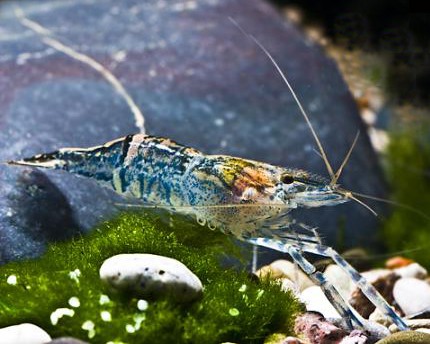
Blue Ghost Shrimp - Macrobrachium sp.
And then there are the large-armed shrimp, about which not much is known yet, because they are newly imported and have not yet been scientifically determined. Of them only the genus is known, so they are listed as Macrobrachium sp. Among them are for example the Blue Ghost Shrimps from India and the Green Apple Macrobrachium, of which we do not even know the reproduction strategy, but also the with 4 cm final size really very small, pretty Bloody Hand Dwarf Macrobrachium. It is known that it can reproduce in fresh water.
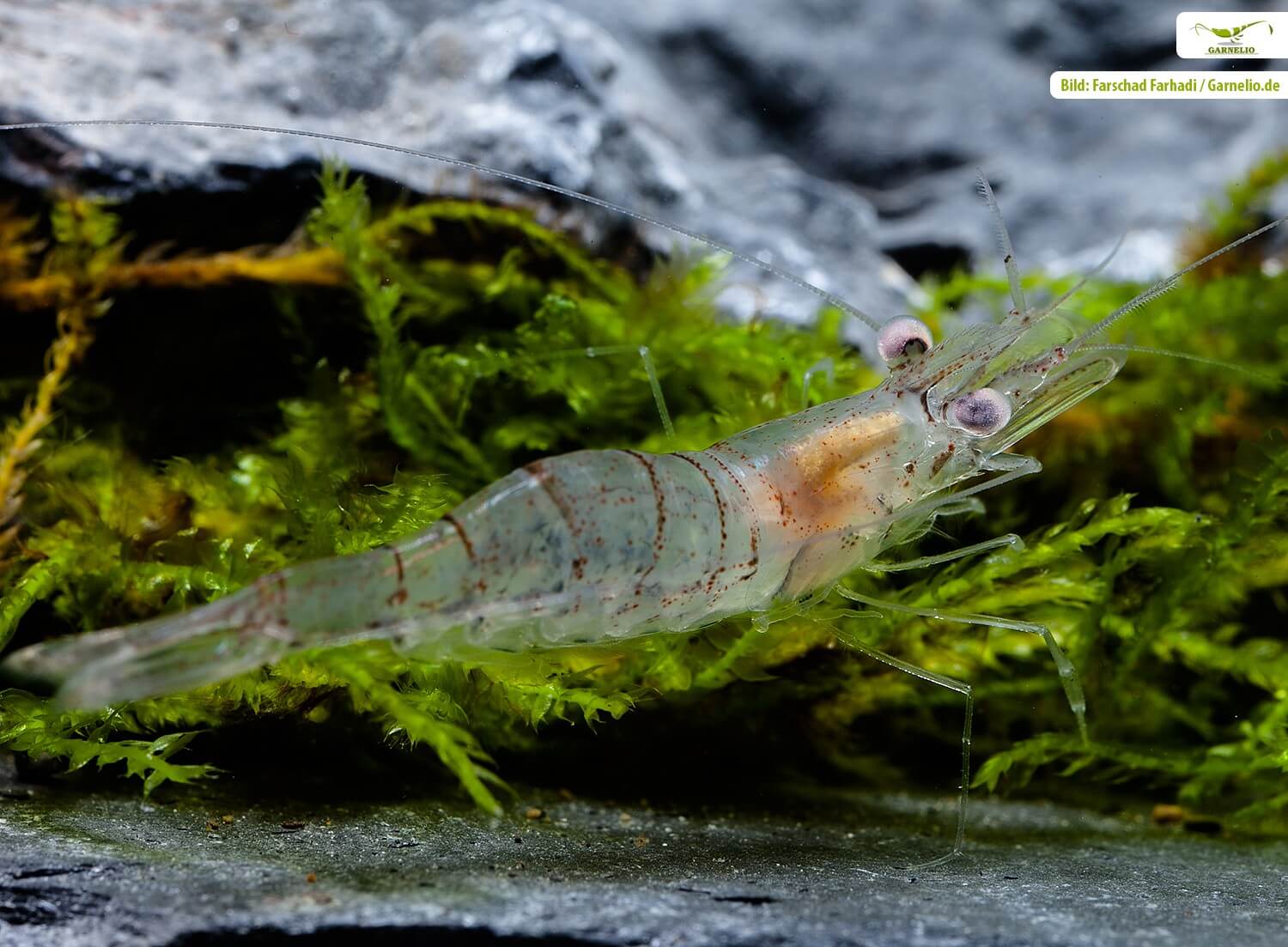
Amazonian leaf shrimp, Euryrhynchus amazoniensis
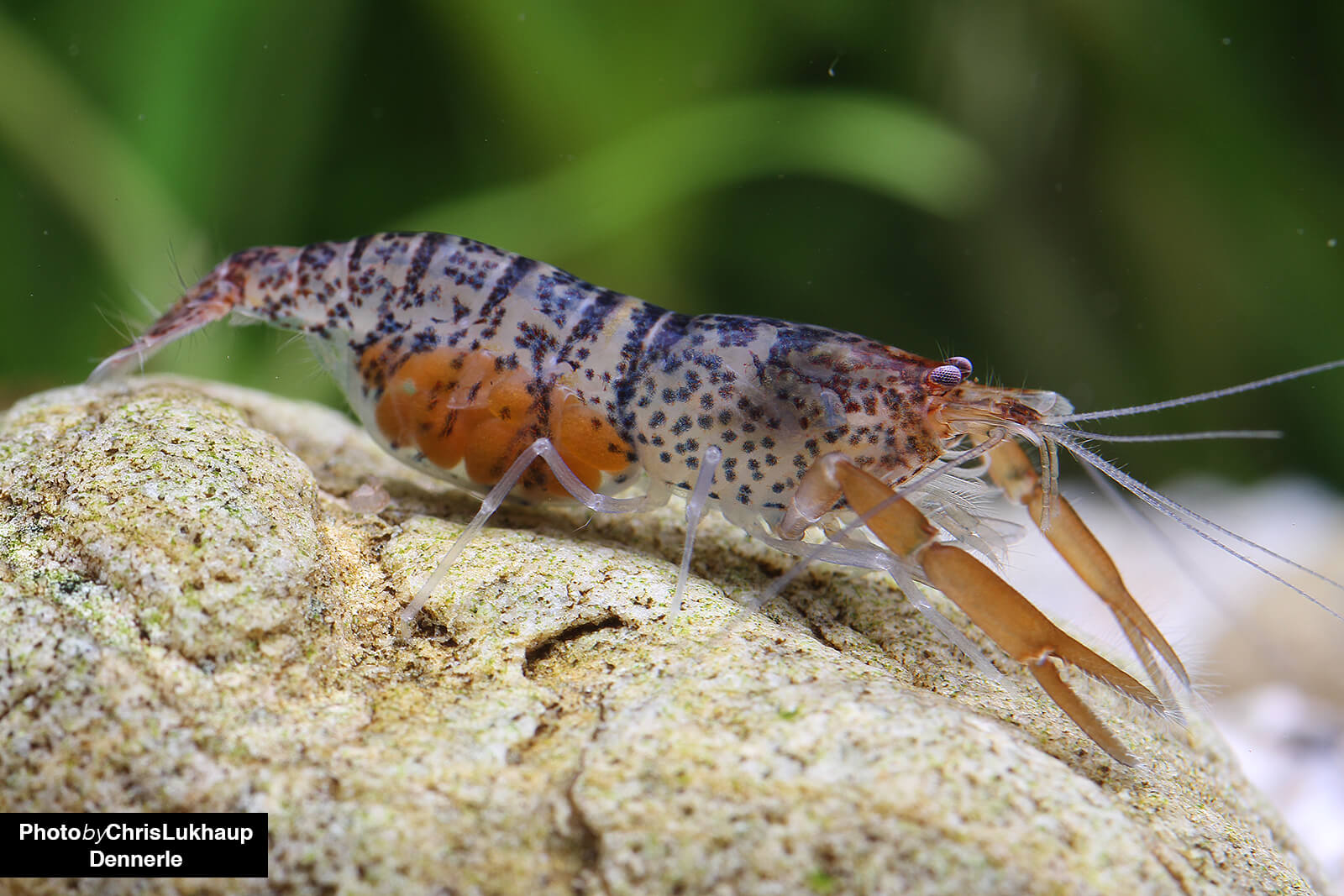
Macrobrachium eiriocheirum
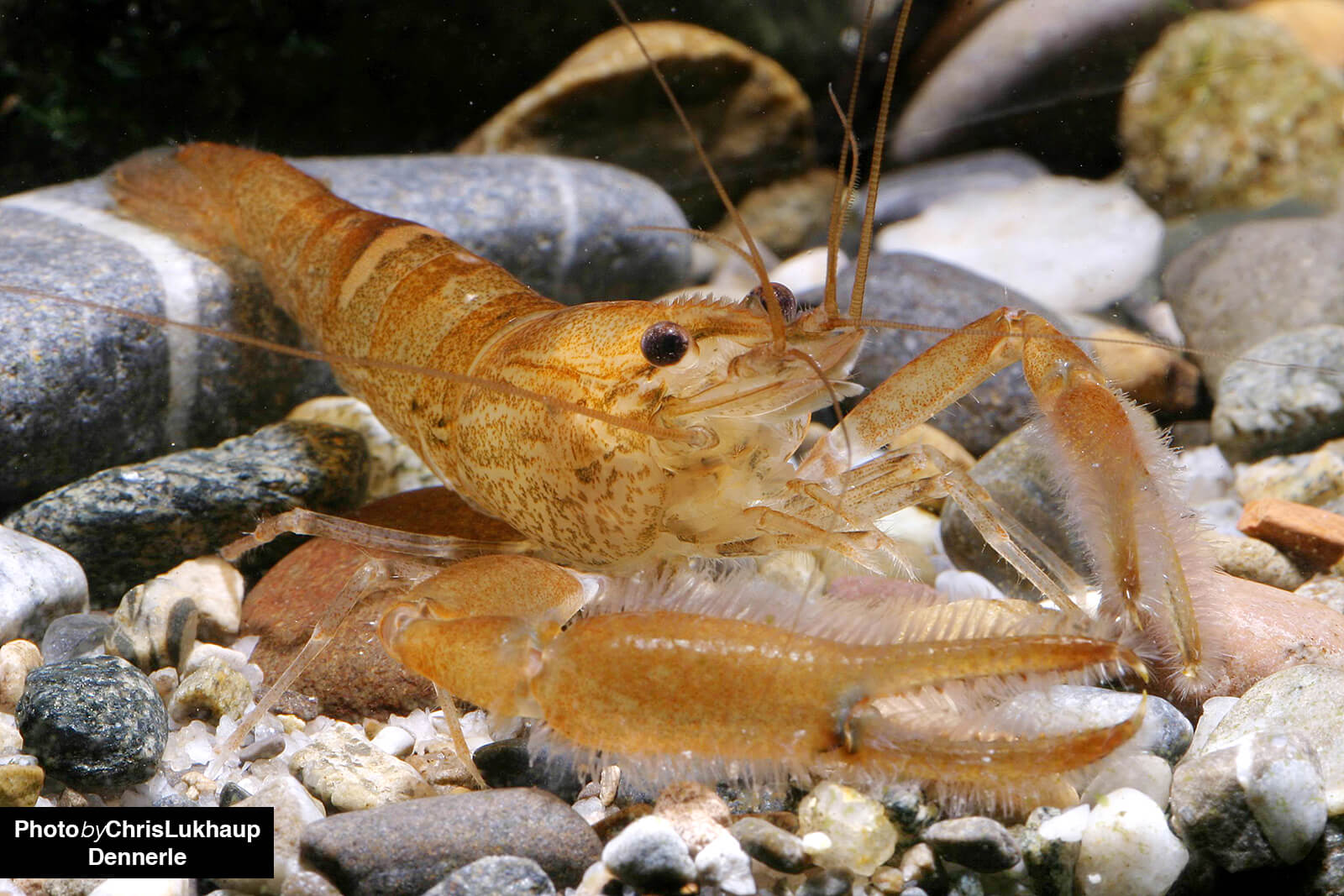
Macrobrachium forcipata
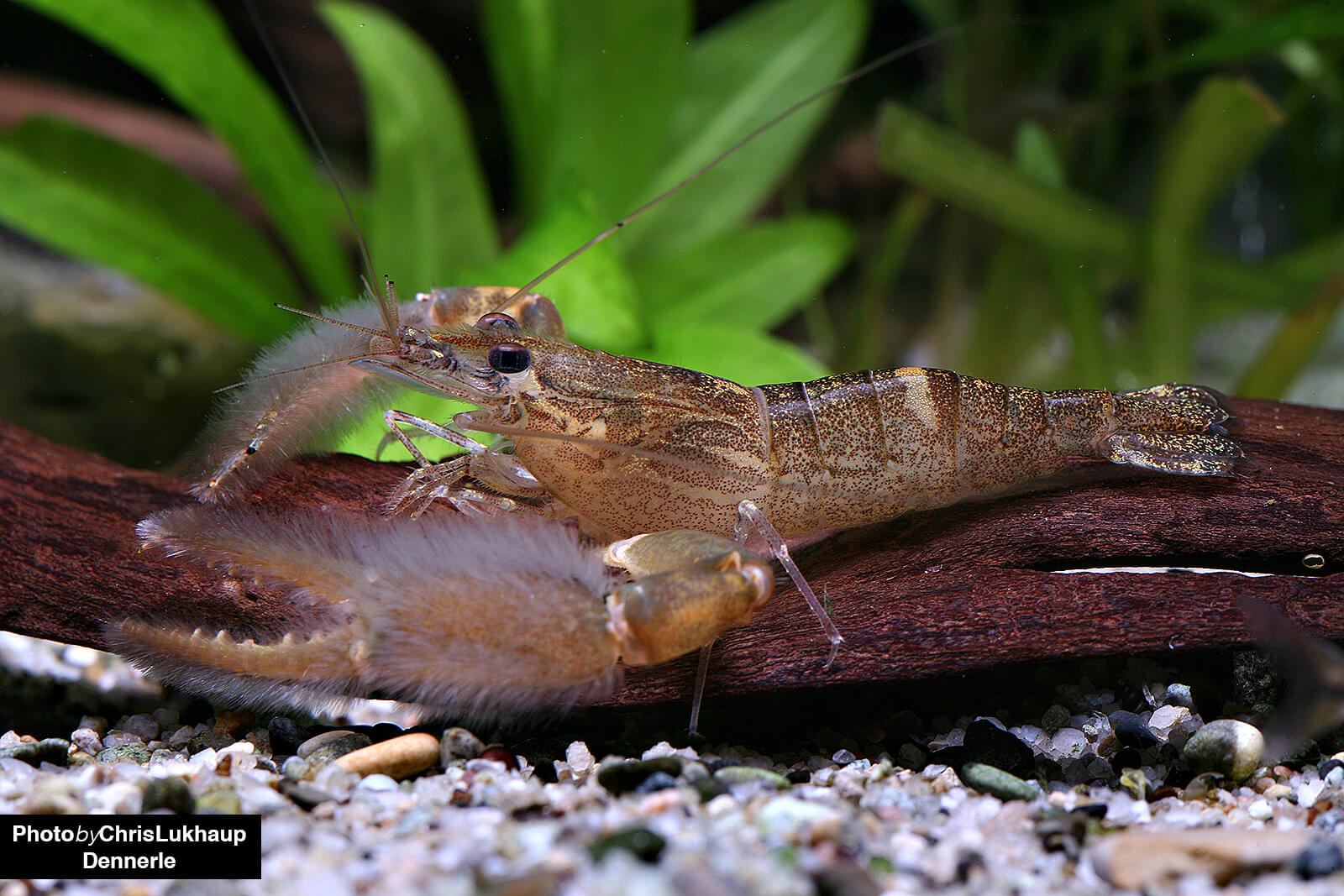
Macrobrachium hancocki

Macrobrachium idae
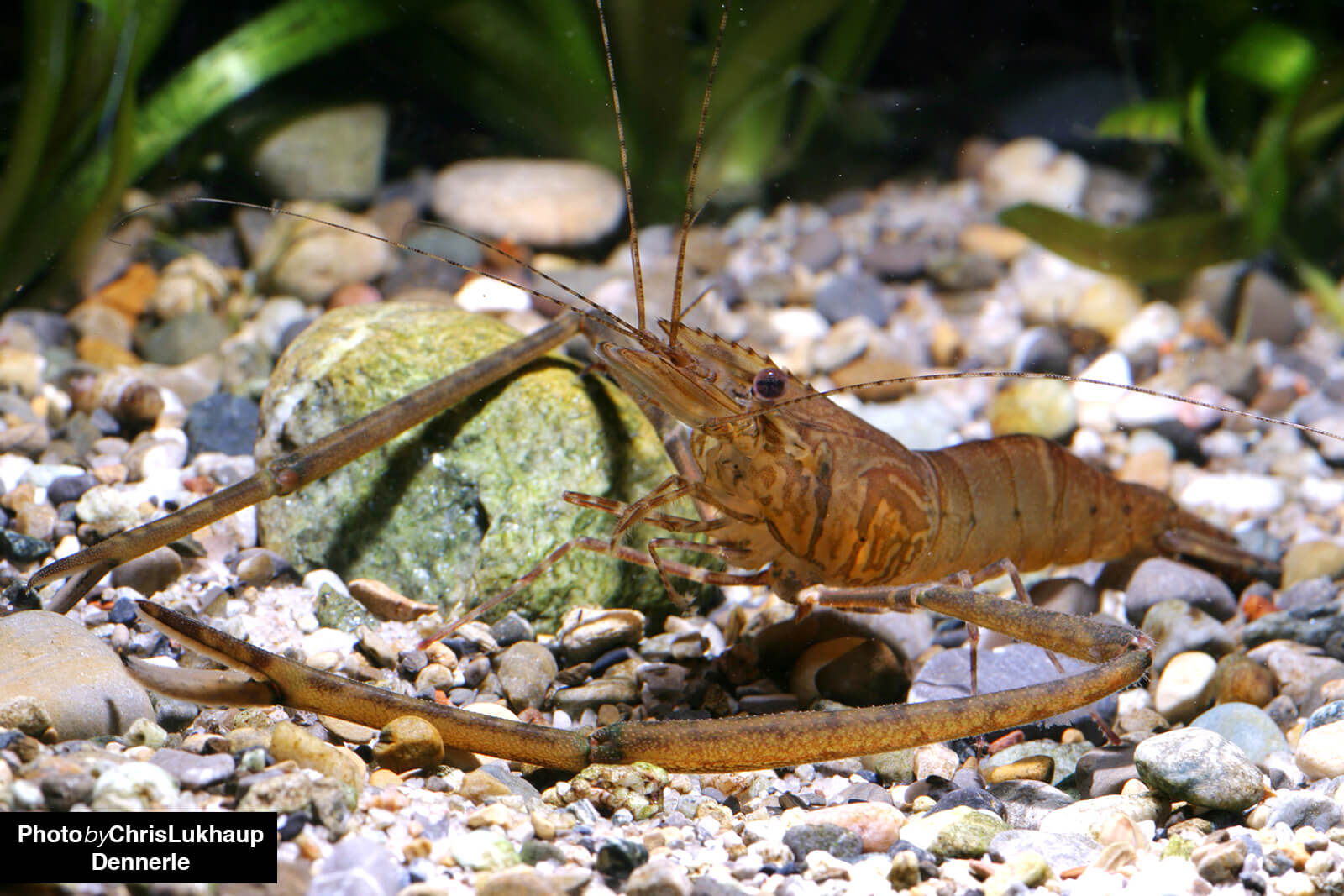
Macrobrachium sp. deep purple
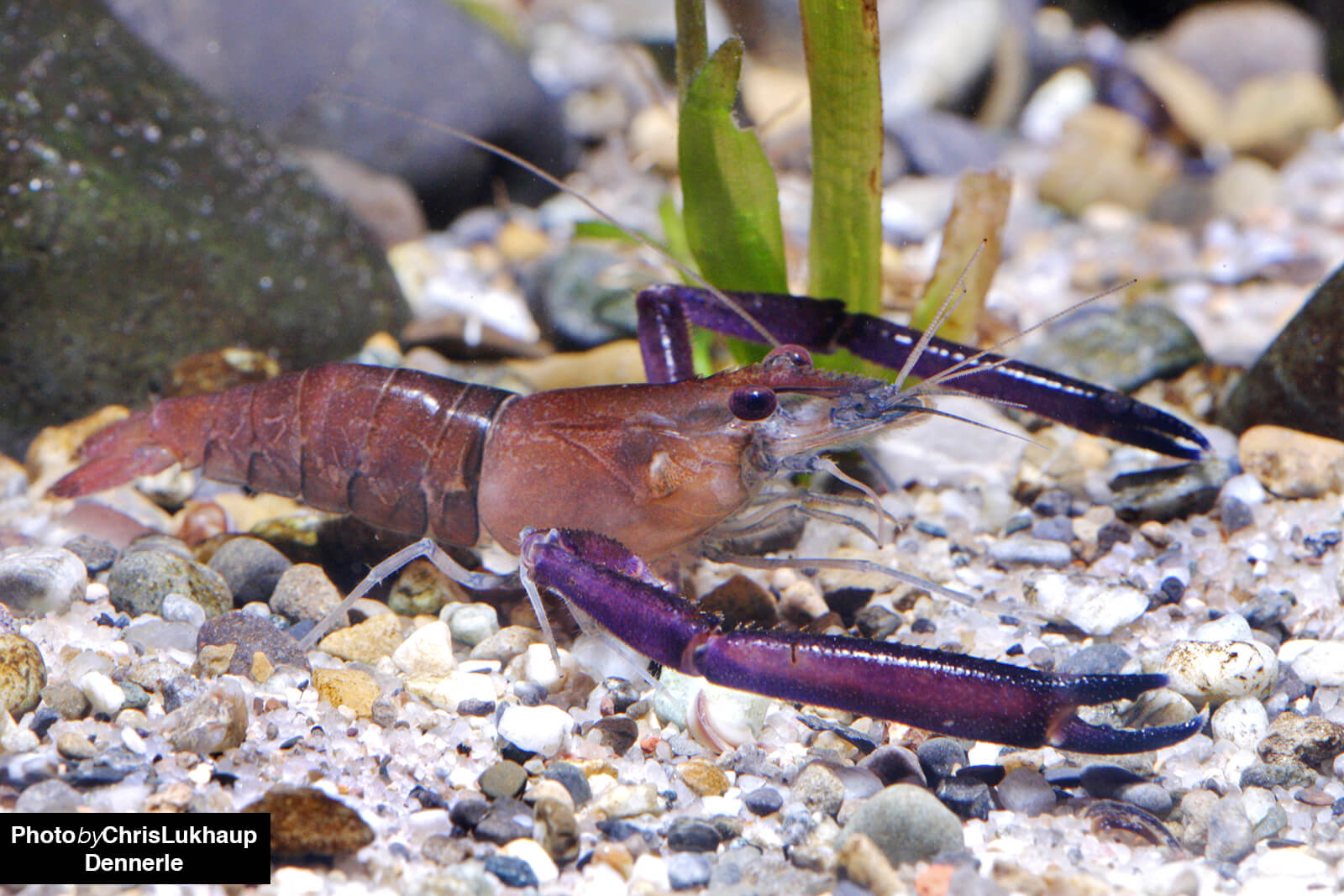
Macrobrachium vollenhovenii
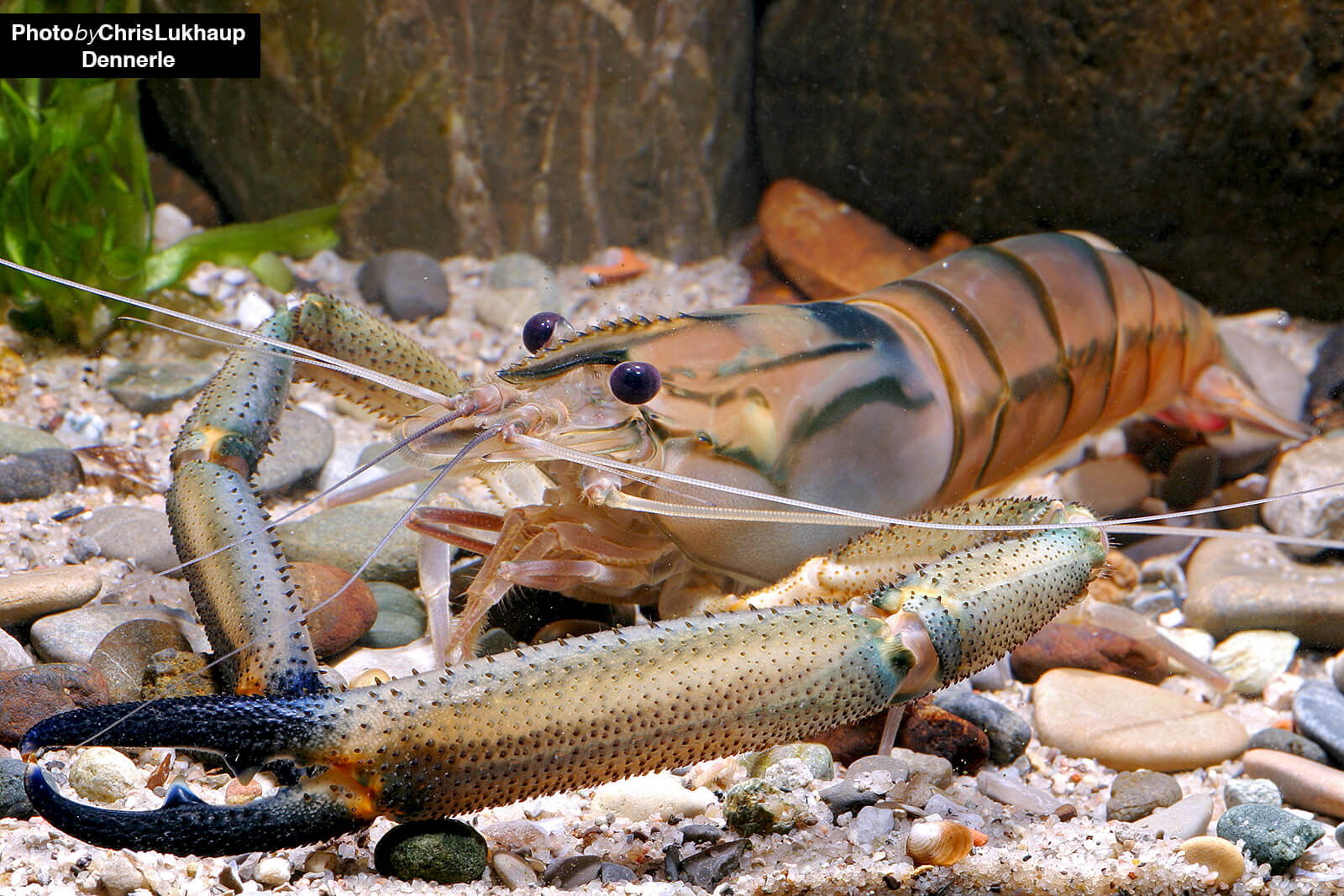
All in all we can say that the end of the line for large arm shrimp has certainly not been reached and that we can look forward to more attractive, relatively easy to keep species.

